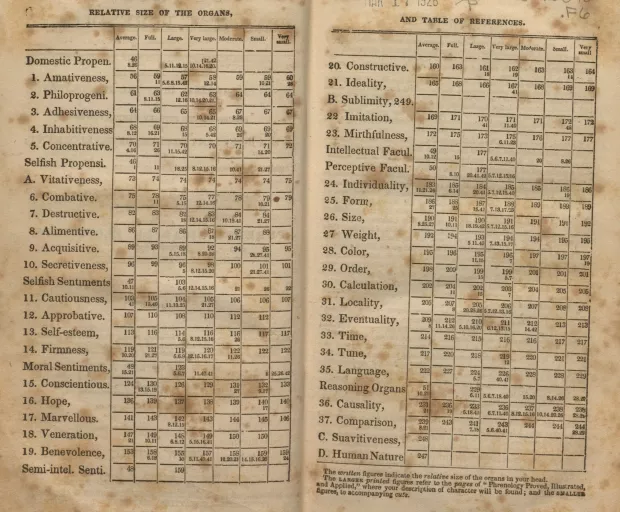Creation Date
18471
Height
14 cm
Width
18 cm
Medium
Genre
Description
This chart provides the "average," "full," "large," "very large," "moderate," "small," and "very small" sizes of the organs measured in each phrenological category.
Fowler’s handbook was described by one reviewer as “the best work now extant on the elementary principles and practical part of the science” (“Article VI” 187). The book, which had sold almost ten thousand copies by 1841, incorporated the work of Franz Joseph Gall, Johann Spurzheim, George Combe, and others into a single comprehensive guide to phrenology (“Article VI” 187). An examination of Fowler’s handbook reveals the extent to which he drew on these preceding thinkers: the names, locations, and descriptions of the organs of interest to phrenology are similar, as is the larger discussion on the uses of phrenology. Fowler also expanded on the work of British phrenologists, discussing physiognomy as well as its sub-science phrenology, providing accounts of the effects of diet and habit on an individual’s character, offering clear directions for the process of phrenological examination, and narrating accounts of successful examinations. The work also included letters objecting to phrenological truths, accompanied by Fowler's own responses in defence of those truths. Furthermore, Fowler expanded the discussion of organs of phrenology; his descriptions span nearly 150 pages. The description of the organ of approbativeness, for example, is given six pages. An individual with a large organ of approbativeness “is extremely sensitive upon every point connected with his honour, his character, his reputation, &c., and, in all he does, will have an eye to the approbation and the disapprobation of his fellow men” (Fowler 108).
Although any of the didactic literature on phrenology might be appropriate here, George Combe’s Outlines of Phrenology is especially appropriate. Combe was one of the earliest advocates of phrenology in the UK; he initiated both the Edinburgh Phrenological Society and its journal, the Phrenological Journal and Miscellany. Combe published several phrenological tracts on the philosophical and scientific backgrounds of phrenology and its use in education, criminal investigation and correction, and theology (Spencer 292). Combe’s books were sold widely in the United States; he also lectured in the United States from 1838 to 1840 (“Advertisement” 76; “Article VI” 187).
Outlines of Phrenology was first published in 1824 and was reprinted in additional editions throughout the nineteenth century (Spencer 292). The pamphlet provided a short explanation of the history of phrenology and its main claims before turning to the methodology of phrenological examination. The majority of the text is concerned with descriptions and illustrations of each organ of interest to phrenologists. The discussion of organ 21, imitation, is typical. After providing the location of the organ (“on the two sides of benevolence”), Combe gives a short discussion of the faculty the organ controls: “The faculty gives the talent for Imitation in general. It contributes to render a poet or author dramatic . . . It aids the portrait-painter, sculptor, and engraver; and it gives the tendency, in speech and conversation, to suit the action to the words” (17). He further provides illustrations of head shapes with large or small organs of imitation (Combe 17).
Charts such as this, included in Fowler’s Practical Phrenology (1847), provided a set of easily understood, “objective” measurements which all people—regardless of their medical training—could use to evaluate others. Such charts and the guides which published them trained the nineteenth-century reader in a gaze which privileged the exterior and the scientific—a gaze Michel Foucault identified as the “clinical gaze” (Foucault 103ff).
Phrenological charts published by Fowler and Wells and others allowed untrained Americans to conduct their own phrenological readings. Similar charts were available for a British audience throughout the 1800s. Fowler’s work and other pieces like it reflect phrenology’s international use. Though arriving a bit later in the United States than in Britain, phrenology was hugely popular in both countries. Almost fifty phrenological organizations had formed in the United States by 1841 (“Article VI" 188). Members of such organizations were hopeful that their “science” would prove successful, even in the face of criticism by some members of the religious and medical communities. One journalist wrote:
It is impossible to estimate the number of believers in phrenology in this country. The science is now embraced by large numbers in the medical profession, especially among the younger portion. It is also favourably received by many members of the legal and clerical professions, and is beginning to be introduced and respectfully treated in our literary, scientific, and medical institutions. The day of its final triumph and general adoption cannot be far distant. ("Article VI" 189)
Associated Works
Copyright
Copyright 2009, Department of Special Collections, Memorial Library, University of Wisconsin-Madison, Madison, WI
Collection
Accession Number
BF 870.F6
Additional Information
Bibliography
"Advertisement 2 -- no Title." Christian Register and Boston Observer (1835-1843) May 13 1843: 76. ProQuest. Web. 1 May. 2009.
“Article VI.” American Phrenological Journal. (1841): 185-9. Print.
Colbert, Charles. A Measure of Perfection. Chapel Hill: U of North Carolina P, 1997. Print.
Combe, George. Outlines of Phrenology. 5th ed. London: Longman & Co., 1835. Print.
Dames, Nicholas. "The Clinical Novel: Phrenology and 'Villette.'" NOVEL: A Forum on Fiction29.3 (1996): 367-390. Print.
Foucault, Michel. The Birth of the Clinic. Trans. Alan Sheridan. New York: Routledge, 2003. Print.
Fowler, Orson Squire. Fowler’s Practical Phrenology: Giving a Concise Elementary View of Phrenology. New York: Fowler & Wells, 1847. Print.
Spencer, Frank. History of Physical Anthropology. New York: Garland Pub., 1997. Print.
Wrobel, Arthur. "Whitman and the Phrenologists: The Divine Body and the Sensuous Soul." PMLA 89.1 (1974): 17-23. Print.

